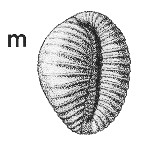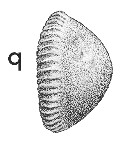
Revised descriptions of New Zealand Cenozoic Mollusca from Beu and Maxwell (1990)

 | Revised descriptions of New Zealand Cenozoic Mollusca from Beu and Maxwell (1990) | 
|
  (Pl. 47m): 032/f8875, Leader River, "Mendip Hills" Station, near Parnassus, North Canterbury, Castlecliffian (GNS) |
  (Pl. 47q): 032/f8875, Leader River, "Mendip Hills" Station, near Parnassus, North Canterbury, Castlecliffian (GNS) |
Beu & Maxwell (1990): Chapter 16; p. 351; pl. 47 m,q.
Synonymy: Trivia zealandica Kirk 1882, p. 409; Trivia neozelanica of Hutton 1893, p. 58 (error); Triviella zealandica; Ellatrivia zealandica
Classification: Triviidae: Triviinae
Description: Moderate-sized for family (10-15 mm high), widely and almost evenly oval, with only slightly protruding apertural extremities, strongly thickened, protruding ridges along sides of base, and smooth, polished dorsum with high-arched, slightly pointed summit. Aperture long and narrow, almost parallel-sided, curved to left at posterior end, with 18 or 19 teeth on outer lip and 18 on inner lip. A few other ridges intercalated between tooth-ridges near outer edges of base; ridges extend only a short way up sides of dorsum, but significantly above callus ridges along the central half of each side. Area between sculptural ridges densely covered with small, distinct pustules; pustules are not seen on dorsum of many specimens, but on well preserved specimens extend over summit of dorsum in a narrow band corresponding to the zone between the mantle lobes of living specimens. Fossula prominent, deeply concave. Spire visibly protruding but thickly callused.
Comparison: The wide, flattened base, the prominent latero-basal ridges similar to those of cowries (Cypraeidae), the presence of sculptural ridges on only the base and lateral callus ridges of mature shells (i.e., their absence from the dorsum), and the presence of pustules between the sculptural ridges and in a band over the dorsum make Trivia zealandica a distinctive species. The living northern North Island Trivia merces occurs rarely in Hawke's Bay Nukumaruan siltstone with T. zealandica, but is easily distinguished by its narrower shape and by having ridges over most or all of the whole dorsum. T. flora (Pitt Island, Waipipian) and T. aequiftora (Pakaurangi Point, Northland, Otaian) resemble T. zealandica closely in having the dorsum almost completely devoid of transverse ridges. The few available specimens of T. flora are smaller than T. zealandica (height 8-10 mm), and have a somewhat narrower aperture; they probably represent a distinct species that possibly was ancestral to T. zealandica. The holotype of T. aequiftora — the only specimen seen — is much smaller than either T. zealandica or T. flora (height only 3.7 mm) and has fewer transverse ridges (11 on inner lip, 15 on outer lip), possibly a reflection of its smaller size. It is likely to be a different species in view of its considerably greater age. All other New Zealand fossil Triviinae differ in having the transverse risges extending more uniformly over the whole exterior surface.
Distribution: Nukumaruan-Castlecliffian; "near Petane", Hawke's Bay, i.e., hillside north of Petane Pa, north of mouth of Esk River, north of Napier, Nukumaruan (type). Not uncommon in Nukumaruan blue-grey siltstone and coquina limestone in central Hawke's Bay (particularly in siltstone at Roro-o-kuri and Watchman Hill, Ahuriri Lagoon, Napier); rare in Wanganui basin and at Castlepoint, Wairarapa (Nukumaruan); rare in Castlecliffian mudstone at Ohope Beach, Bay of Plenty, and Leader River on "Mendip Hills" station, near Parnassus, North Canterbury (figured).
Cite this publication as: "A.G. Beu and J.I. Raine (2009). Revised
descriptions of New Zealand Cenozoic Mollusca from Beu and Maxwell (1990). GNS
Science miscellaneous series no. 27."
© GNS Science, 2009
ISBN
978-0-478-19705-1
ISSN 1177-2441
(Included with a PDF facsimile file
copy of New Zealand Geological Survey Paleontological Bulletin 58 in CD version
from: Publications Officer, GNS Science, P.O. Box 30368 Lower Hutt, New
Zealand)